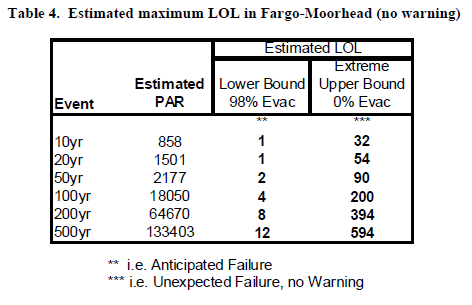Federal Guidelines for Dam Safety: Glossary of Terms
FEMA defines a “dam” as an artificial barrier that has the ability to impound water, wastewater, or any liquid-borne material, for the purpose of storage or control of water.
FEMA classifies dams according to the potential impact a dam failure (breach) or mis-operation (unscheduled release) would have on upstream and/or downstream areas or at locations remote from the dam.
Minnesota DNR classifies the Fargo Moorhead Dam and Diversion water control structure as a Class 1 – high hazard dam, which requires preparation of a seperate Minnesota State EIS.
Under Minnesota Hazard Classification statute:
Class 1 – any loss of life or serious hazard, or damage to health, main highways, highvalue industrial or commercial properties, major public utilities, or serious direct or indirect economic loss.
Cited Source: http://damsafety.org
Download (pdf) Version – 22kFEMA’s loss of life threshold is (1) one or more lives for high hazard dams where failure or misoperation will probably cause loss of human life.
Hazard Potential Classification Loss of Human Life Economic, Environmental, Lifeline Losses Low None expected Low and generally limited to owner Significant None expected Yes High Probable. One or more expected Yes (but not necessary for this classification)
Cited Source: FEMA-333 Report
Federal Guidelines – Hazard Potential Classification – FEMA-333 Report – 134kThe current FEIS indicates loss of life probabilities due to sudden failure which exceeds FEMA’s minimum loss of life threshold:
Data from Table 4 Appendix D
Estimated maximum LOL in Fargo-Moorhead (no warning)
200 lives lost – 100 year event
394 lives lost – 200 year event
594 lives lost – 500 year event
Views: 825

